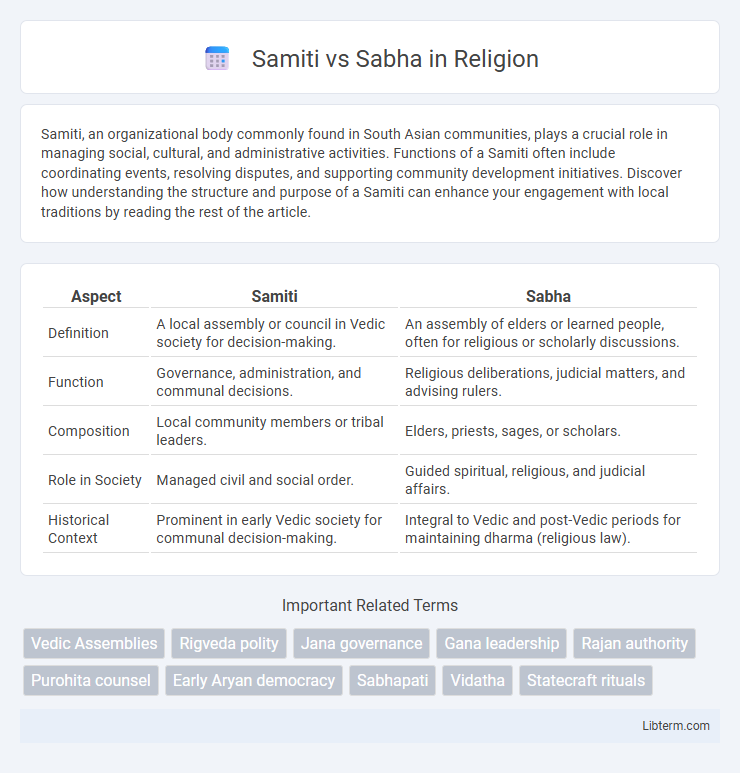Samiti, an organizational body commonly found in South Asian communities, plays a crucial role in managing social, cultural, and administrative activities. Functions of a Samiti often include coordinating events, resolving disputes, and supporting community development initiatives. Discover how understanding the structure and purpose of a Samiti can enhance your engagement with local traditions by reading the rest of the article.
Table of Comparison
| Aspect | Samiti | Sabha |
|---|---|---|
| Definition | A local assembly or council in Vedic society for decision-making. | An assembly of elders or learned people, often for religious or scholarly discussions. |
| Function | Governance, administration, and communal decisions. | Religious deliberations, judicial matters, and advising rulers. |
| Composition | Local community members or tribal leaders. | Elders, priests, sages, or scholars. |
| Role in Society | Managed civil and social order. | Guided spiritual, religious, and judicial affairs. |
| Historical Context | Prominent in early Vedic society for communal decision-making. | Integral to Vedic and post-Vedic periods for maintaining dharma (religious law). |
Introduction to Samiti and Sabha
Samiti and Sabha are key institutions in ancient Indian governance, with Samiti referring to an assembly of the entire community or tribe, often responsible for decision-making on public and political matters. Sabha is a smaller council or assembly usually composed of elders or select members who advised the king or ruler on judicial and administrative issues. Both played crucial roles in shaping early democratic practices and societal governance in Vedic India.
Historical Origins of Samiti and Sabha
Samiti and Sabha originated in ancient Vedic society as fundamental assemblies for communal decision-making and governance. The Samiti was an early tribal council emphasizing collective deliberation among elders, primarily concerned with administrative and military matters during the Rigvedic period. In contrast, the Sabha evolved as a more specialized and organized body, functioning as a judicial and legislative council that supported the king's authority in later Vedic and post-Vedic times.
Meaning and Definition: Samiti
Samiti refers to an assembly or council in ancient Indian polity, often associated with decision-making and governance in tribal or community settings. It functioned as a deliberative body where members discussed and resolved social, political, and economic issues. The concept of Samiti emphasizes collective participation and consensus within a structured group or committee.
Meaning and Definition: Sabha
Sabha refers to an assembly or council in ancient Indian governance, typically comprising elders or representatives who deliberate on important matters. It functioned as a formal gathering for decision-making and discussion within the kingdom or community, emphasizing collective consultation. The term "Sabha" is often distinguished from "Samiti," which denotes a more general or popular assembly.
Composition and Structure of Samiti
Samiti typically consists of elected representatives from local or regional bodies, including members from Panchayats, municipal councils, and other local authorities, ensuring diverse community representation. The structure of Samiti is organized into various committees, each focusing on specific administrative functions such as health, education, and public works, facilitating specialized governance. Unlike Sabha, which may include a broader public assembly, Samiti operates with a more defined and formal membership, enabling streamlined decision-making and implementation of local policies.
Composition and Structure of Sabha
Sabha typically comprises a body of elected or appointed representatives serving as a legislative or deliberative assembly, often structured with a clear hierarchy including a speaker or chairman, committees, and members who participate in debates and decision-making processes. Its composition is designed to reflect a broader population or stakeholders, ensuring diverse representation and structured governance. The Sabha's organized framework supports formal legislative procedures, contrasting with the more localized or functional nature of a Samiti.
Functions and Roles of Samiti
Samiti primarily functions as an executive committee responsible for the implementation of policies and administrative decisions within Panchayati Raj institutions, coordinating development programs and managing local resources effectively. It ensures accountability by monitoring the execution of schemes related to agriculture, health, education, and infrastructure at the village or block level. Unlike Sabha, which emphasizes participatory decision-making and community engagement, Samiti plays a pivotal role in governance and administrative management, facilitating smooth functioning of local self-government bodies.
Functions and Roles of Sabha
The Sabha primarily functions as a council or assembly responsible for deliberating on community issues, making collective decisions, and upholding justice in ancient Indian governance. It plays a crucial role in maintaining social order, resolving disputes, and advising the ruler on administrative and legislative matters. The Sabha's functions often include supervising economic activities, organizing public works, and ensuring the welfare of the people within its jurisdiction.
Key Differences: Samiti vs Sabha
Samiti primarily functions as a committee responsible for specific administrative or executive tasks, whereas Sabha serves as a deliberative assembly focused on decision-making and discussion. Samiti often involves a smaller group of appointed or elected members managing day-to-day operations, while Sabha includes a larger gathering that provides broader representation and collective resolutions. Key differences lie in their roles: Samiti executes policies, and Sabha debates and approves those policies.
Significance and Legacy in Ancient Indian Polity
Samiti and Sabha were essential governing bodies in ancient Indian polity, with Samiti representing a larger general assembly or tribal council, while Sabha functioned as a more selective, advisory council of elders or nobles. The Samiti played a critical role in collective decision-making, war mobilization, and social welfare, reflecting early democratic practices and community participation. The Sabha's significance lay in its judicial and administrative authority, setting precedents for structured governance and legal procedures, influencing the legacy of political organization in later Indian kingdoms.
Samiti Infographic

 libterm.com
libterm.com